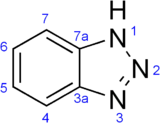Benzotriazole
 |
|
 |
|
| Names | |
|---|---|
| Other names
1H-Benzotriazole, 1,2,3-Benzotriazole, BtaH
|
|
| Identifiers | |
|
95-14-7 |
|
| 3D model (Jmol) | Interactive image |
| ChEBI |
CHEBI:75331 |
| ChEMBL |
ChEMBL84963 |
| ChemSpider |
6950 |
| ECHA InfoCard | 100.002.177 |
| PubChem | 7220 |
|
|
|
|
| Properties | |
| C6H5N3 | |
| Molar mass | 119.13 g·mol−1 |
| Appearance | White solid |
| Density | 1.36 g/mL |
| Melting point | 100 °C (212 °F; 373 K) |
| Boiling point | 350 °C (662 °F; 623 K) |
| 20 g/L | |
| Acidity (pKa) | 8.2 |
| Basicity (pKb) | < 0 |
| Hazards | |
| Main hazards | XN |
| R-phrases | R20/22 R36 R52/53 |
| S-phrases | – |
| R/S statement | – |
| Related compounds | |
|
Related compounds
|
Benzimidazole |
|
Except where otherwise noted, data are given for materials in their standard state (at 25 °C [77 °F], 100 kPa).
|
|
|
|
|
| Infobox references | |
Benzotriazole (BTA) is a heterocyclic compound containing three nitrogen atoms, with the chemical formula C6H5N3. This aromatic compound is colorless and polar and can be used in various fields.
Benzotriazole features two fused rings. Its five-membered ring can exist in tautomers A and B, and the derivatives of both tautomers, structures C and D also can be produced.
Various structural analyses with UV, IR and 1H-NMR spectra indicated that isomer A is predominantly present at room temperature. The bond between positions 1 and 2 and the one between positions 2 and 3 have proved to have the same bond properties. Moreover, the proton does not tightly bind to any of the nitrogen atoms, but rather migrates rapidly between positions 1 and 3. Therefore, the BTA can lose a proton to act as a weak acid (pKa = 8.2) or accept a proton using the lone pair electrons located on its nitrogen atoms as a very weak Bronsted base (pKa < 0). Not only can it act either as an acid or base, it can also bind to other species, utilizing the lone pair electrons. Applying this property, the BTA can form a stable coordination compound on a copper surface and behave as a corrosion inhibitor.
A synthesis of the BTA involves the reaction of o-phenylenediamine, sodium nitrite and acetic acid. The conversion proceeds via diazotization of one of the amine groups.
The synthesis can be improved when the reaction is carried out at low temperatures (5-10 ˚C) and briefly irradiated in an ultrasonic bath. Typical batch purity is 98.5% or greater
Benzotriazole has been known for its great versatility. It has already been used as a restrainer in photographic emulsions and as a reagent for the analytical determination of silver. More importantly, it has been extensively used as a corrosion inhibitor in the atmosphere and underwater. Also, its derivatives and their effectiveness as drug precursors have been drawing attention. Besides all the application mentioned above, the BTA can be used as antifreezes, heating and cooling systems, hydraulic fluids and vapor phase inhibitors as well.
...
Wikipedia
